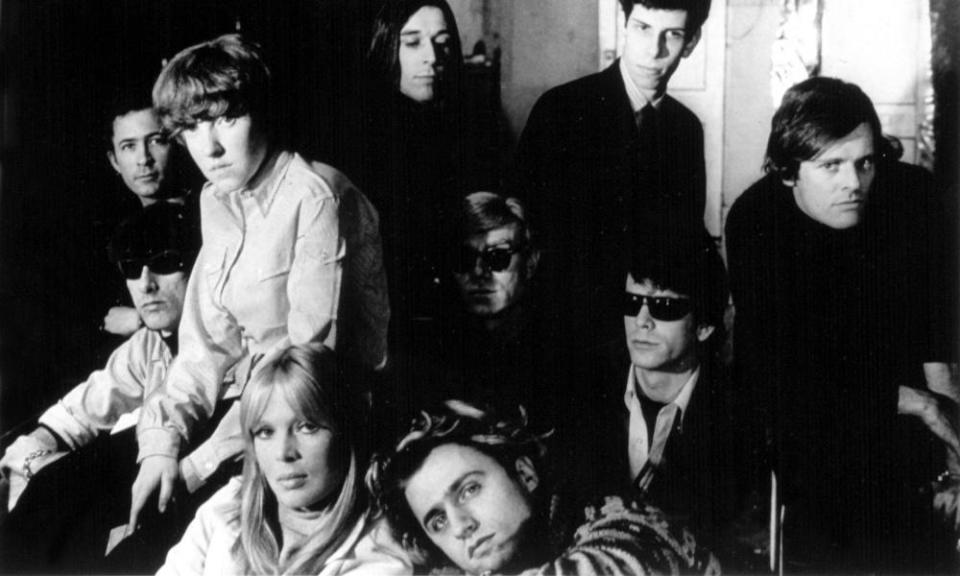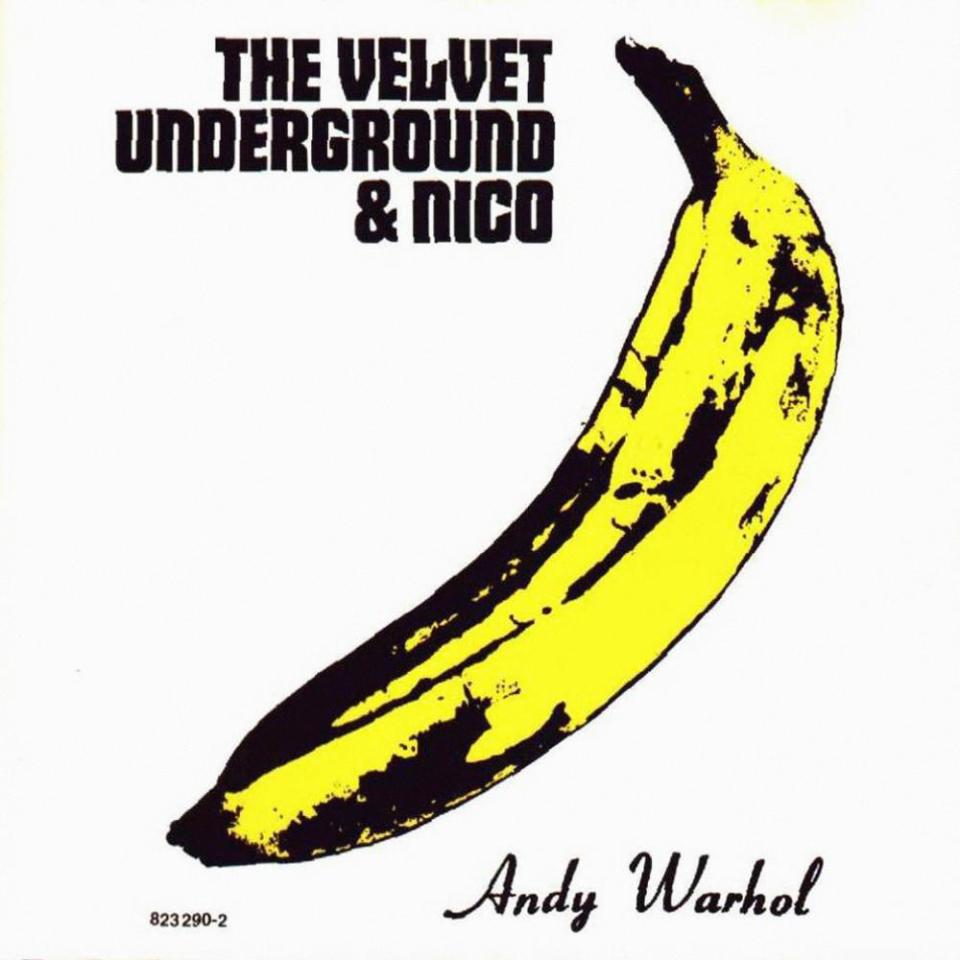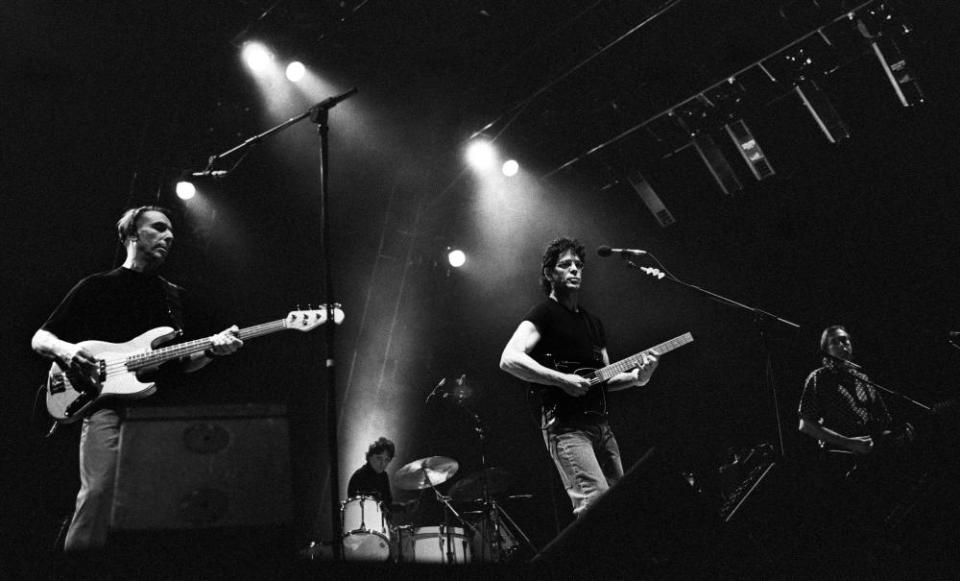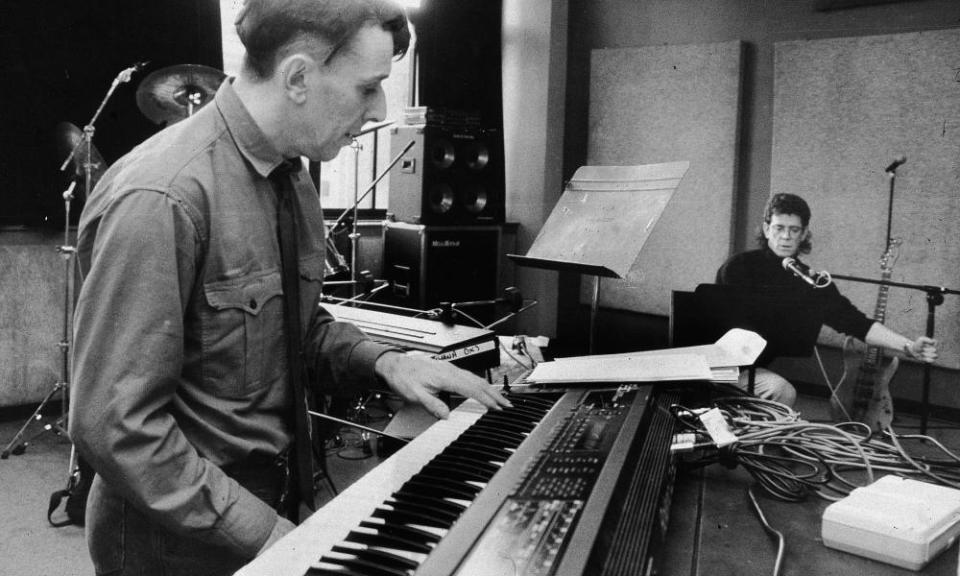‘They didn’t go round the corner for beer’: Lou Reed and John Cale’s Songs for Drella
After years of estrangement, the two Velvet Underground musicians decided to make a record and filmed concert about their mentor Andy Warhol. Director Ed Lachman talks about how he captured the pair in action
Andy Warhol never goes away, but 35 years after his death, he is everywhere. There are The Andy Warhol Diaries and Andy Warhol’s America on TV, The Collaboration and Chasing Andy Warhol in theatres on either side of the Atlantic, while Christie’s is hoping to net a record-setting $200m (£152m) when it auctions a 1964 Marilyn screen print next month.
Related: Songs for Drella review – Lou Reed and John Cale’s moving journey into Warhol
Whole forests have been flattened trying to unravel the Warhol enigma – Blake Gopnik’s 2020 biography thuds in at 976 pages. Yet in just 55 minutes, Lou Reed and John Cale’s 1990 album and film Songs for Drella get to the heart of a man obscured by his wig, shades and blank expression. Their song cycle starts with Smalltown, a jaunty portrait of Warhol’s childhood in Pittsburgh, “Bad skin, bad eyes, gay and faddy” (or is it “fatty”?), through his hyper-productive golden era in the 60s, to his later years battling pain from the wounds sustained when he was shot by Valerie Solanas, author of the Society for Cutting Up Men Manifesto, alienation from collaborators and friends, and a growing dearth of ideas. All the themes biographers have subsequently treated as great revelations – Warhol’s Catholicism, his queerness, his relationship with his mother – are here, explored with taut precision and economy.

Reed and Cale, of course, had a particular insight into Warhol. They were the creative engine of the Velvet Underground, the rock band the artist managed and produced and whose first album, The Velvet Underground & Nico, ignored on release, became a bible for glam rockers, drag queens, junkies and punks, and is arguably the most influential LP ever made. Given that Reed fired Warhol, then slung Cale out of the band a year later (not face to face, either – he got guitarist Sterling Morrison to do it) relations between the three men were less than cordial. Even the title Songs for Drella is ambivalent: Drella was a nickname used behind Warhol’s back, and which he didn’t like, a conflation of Dracula (the blood-sucking night creature) and Cinderella (the servant who goes to the ball). Yet without any sentimentality, Songs for Drella reveals the warm currents of respect and friendship that lay deep beneath the frosty surface.

Warhol died suddenly in 1987 after routine gall bladder surgery, aged 58. Cale and Reed decided to make Songs for Drella after meeting at his memorial service – the first time they’d spoken in years. They finally performed its 14 songs in full at the Brooklyn Academy of Music, New York, at the end of 1989. Presumably with an eye on the combustible nature of the partnership, as well as on its great cultural significance, someone decided that this performance should be filmed for posterity. Enter the great cinematographer Ed Lachman. Now 76, Lachman photographed Far from Heaven and Carol for Todd Haynes, earning Oscar nominations for both films, and has worked with Sofia Coppola, Wim Wenders and Werner Herzog. It was, however, a music video that got him the Songs for Drella gig.
“There was an Aids benefit compilation called Red Hot + Blue,” he remembers, Zooming from a colour correction studio in New York, he is squashed into a corner of the frame so all I can see is one lively eye and his fedora. “I was going to make a video with Derek Jarman and Annie Lennox, but Derek was too sick by then.”
Jarman had been diagnosed as HIV positive in 1986, and was to become seriously ill making his 1990 film The Garden. “We met and he gave me home movies of his family when he was growing up, so I had the idea of projecting the images of his childhood over the white pancake face of Annie singing the Cole Porter song Ev’ry Time We Say Goodbye. It was gorgeous and it got a lot of notice, and that’s why Channel 4 came to me and offered me to do this concert.” Yes, the TV station about to be sold off by Nadine Dorries co-produced Songs for Drella, along with Sire Records in the US.
Lachman had a meeting with Cale and Reed to discern whether he met with their approval. “Lou was very emphatic and said: ‘I don’t want to see any cameras on the stage and I don’t want cameras to be between me and the audience. Are you all right with that?’ So I said: ‘Well, I don’t know how I’m going to shoot the concert without any cameras.’
“I thought about it, came back the next day and said to them ‘Look, would you let me shoot two of your rehearsals on the stage with no one in the audience and I’ll shoot the performance but the cameras will be off the stage?’ And he agreed.”
The result is unlike any other concert film. Lachman’s 16mm camera is so close to the two protagonists that you seem to be reading their thoughts – both about Warhol and about each other. Filmed when both men were 47, Cale looks aristocratic in a black suit and fabulous wedge haircut, while Reed serves disgruntled librarian in a black sweater and octagonal spectacles. Neither of them look like rock stars, and they’re both concentrating hard, facing one another while delivering the vocals (singing isn’t quite the right word in Reed’s case) and hammering on the piano or guitar. Though there are no drums on Songs for Drella, the music is often spiky and percussive – not least on I Believe, in which Reed startlingly declares that Solanas should have received the death penalty for shooting Warhol. In fact she got three years, which tells you something about the low regard in which gay lives were held, even famous ones.
As with the Velvet Underground, the abrasive moments are leavened with others of intense sweetness – for instance Style It Takes, in which Warhol coaxes a gorgeous young thing into performing in one of his screen-test films, and which features the self-referential lines: “This is a rock group called the Velvet Underground / I show movies on them, do you like their sound?” At moments like this, the camera lingers on Reed and Cale’s faces. “Sven Vilhem Nykvist, the great cinematographer of Ingmar Bergman, said the face is the landscape for the camera,” Lachman notes. “If there were ever faces that could be landscapes it would be theirs.”

Towards the end of Songs for Drella a mood of self-admonishment takes hold, for instance in A Dream, where Cale recites lines taken from Warhol’s diaries such as: “You know I hate Lou, I really do. He won’t even hire us for his videos, and I was so proud of him …” It’s at this point that you look even more closely at Reed and Cale. There’s so much to wonder about as you gaze at their inscrutable expressions. Can we discern regret at their meanness, both to Warhol and to each other, pride in the blazing mutual creativity of their youth, sorrow that it’s too late to do things differently?
“It was not only a tribute, an homage, a eulogy, but it was also sort of a confessional,” says Lachman. To that end, Cale and Reed were filmed in near darkness, sometimes with Warhol’s artworks, or the New York Post front page that sneered “Pop goes pop artist” after the shooting, projected above them. “Cameramen like to separate people from the darkness,” Lachmnan adds, “but I wanted them to emerge out of the darkness.”
Lachman had first met Reed years before – he had been enlisted to make a video clip for Reed’s baroquely gloomy 1973 album Berlin. “He came up to the camera when I was setting it up, kicked the leg of the tripod and said: ‘Do it like Andy’. I was horrified, I was trying to hold on to the camera that was about to fall on the floor.” By the time of Songs for Drella, Reed had sobered up. “I asked him if he remembered that, and he said ‘I don’t remember much from back then’, smiled and walked back to the microphone.”

So what was the atmosphere like between Cale and Reed? Did they joke around? “What you see is what you got,” Lachman says. “They showed up and they did the work. I wasn’t hanging out with them after or before, I had my hands full. They didn’t go round the corner for beer.” Indeed, Reed and Cale fell out in the aftermath of Songs for Drella – “Lou always has to be in control,” Lachman notes – before making up and deciding to reform the Velvet Underground. The band toured Europe in 1993 (including, improbably, an appearance at Glastonbury) before Cale and Reed became estranged again. That was it until the band were inducted into the Rock’n’Roll Hall of Fame in 1996, which turned out to be their final performance. Reed died in 2013, aged 71; Cale is now 80. He rebuffed approaches to talk about this film.
Songs for Drella was broadcast on Channel 4 in 1990, a performance I recorded on VHS, and which seemed to my teenage self to be a transmission from a planet of cryogenic coolness. It’s lived deep within my bones ever since, so it’s a shock to hear that it had actually been “lost” since that first broadcast. In the US, it was released on a laser disc, then disappeared. Lachman tried to find the film while working on Todd Haynes’s documentary about the Velvet Underground, and finally located it during the pandemic, going through boxes of material he’d requested from the Motion Picture Lab in New York. “There, 100ft from my bed, was the actual original negatives, but no sound,” he says. Warner Brothers supplied him with the original sound mix, “and I was able through sound restoration to sync it up, and it now has the best possible sound it could.”
Related: Yours for $200m: why Warhol is now worth more than Picasso
The restored version now lives again on the streaming platform Mubi, and looks and sounds divine, Lachman filming each song in a subtly different way, some in monochrome, like the concluding Hello It’s Me, in which Reed expresses regret for the things he didn’t say to Warhol: “I wished I talked to you more when you were alive / I thought you were self-assured when you acted shy …”
“For me, the camera has a taciturn observation, almost like Andy,” Lanchman says. “A lot of people felt Andy was a voyeur, some kind of svengali, but I think he was much more passive and he lived through the people that he made stars.”
Of course, it’s Warhol’s presence above all that hangs over Songs for Drella, that tricky, far-sighted ghost summoned in the memories of those who knew him best. “I always felt that it was the spirit of Andy that brought John and Lou together,” Lachman says. “His spirit was still with them.”
Songs for Drella is on Mubi from 17 April.

 Yahoo News
Yahoo News 
